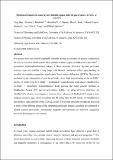Files in this item
Structural features in some layered hybrid copper chloride perovskites : ACuCl4 or A2CuCl4
Item metadata
| dc.contributor.author | Han, Ceng | |
| dc.contributor.author | Bradford, Alasdair J. | |
| dc.contributor.author | Slawin, Alexandra M. Z. | |
| dc.contributor.author | Bode, Bela E. | |
| dc.contributor.author | Fusco, Edoardo | |
| dc.contributor.author | Lee, Stephen L. | |
| dc.contributor.author | Tang, Chiu C. | |
| dc.contributor.author | Lightfoot, Philip | |
| dc.date.accessioned | 2022-07-08T23:38:32Z | |
| dc.date.available | 2022-07-08T23:38:32Z | |
| dc.date.issued | 2021-07-09 | |
| dc.identifier | 275024771 | |
| dc.identifier | bad55e63-133f-406f-87bf-adfc45a5e63b | |
| dc.identifier | 85111172873 | |
| dc.identifier | 000682991300018 | |
| dc.identifier.citation | Han , C , Bradford , A J , Slawin , A M Z , Bode , B E , Fusco , E , Lee , S L , Tang , C C & Lightfoot , P 2021 , ' Structural features in some layered hybrid copper chloride perovskites : ACuCl 4 or A 2 CuCl 4 ' , Inorganic Chemistry , vol. Articles ASAP . https://doi.org/10.1021/acs.inorgchem.1c00705 | en |
| dc.identifier.issn | 0020-1669 | |
| dc.identifier.other | RIS: urn:AE64ACA9C7698BAC45F25CA5C7E27FE8 | |
| dc.identifier.other | ORCID: /0000-0001-7048-3982/work/97129645 | |
| dc.identifier.other | ORCID: /0000-0002-2020-3310/work/97129730 | |
| dc.identifier.other | ORCID: /0000-0002-3384-271X/work/97129824 | |
| dc.identifier.other | ORCID: /0000-0002-9527-6418/work/97129741 | |
| dc.identifier.uri | https://hdl.handle.net/10023/25640 | |
| dc.description | We thank STFC for the provision of data collected at Diamond (Experiment CY23579). We acknowledge support from the University of St Andrews, the China Scholarship Council (studentship to C.H.), and the University of St Andrews (studentship to A.J.B. and E.F.). | en |
| dc.description.abstract | We present three new hybrid copper(II) chloride layered perovskites of generic composition ACuCl4 or A2CuCl4, which exhibit three distinct structure types. (m-PdH2)CuCl4 (m-PdH22+ = protonated m-phenylenediamine) adopts a Dion–Jacobson (DJ)-like layered perovskite structure type and exhibits a very large axial thermal contraction effect upon heating, as revealed via variable-temperature synchrotron X-ray powder diffraction (SXRD). This can be attributed to the contraction of an interlayer block, via a slight repositioning of the m-PdH22+ moiety. (3-AbaH)2CuCl4 (3-AbaH+ = protonated 3-aminobenzoic acid) and (4-AbaH)2CuCl4 (4-AbaH+ = protonated 4-aminobenzoic acid) possess the same generic formula as Ruddlesden–Popper (RP) layered perovskites, A2BX4, but adopt different structures. (4-AbaH)2CuCl4 adopts a near-staggered structure type, whereas (3-AbaH)2CuCl4 adopts a near-eclipsed structure type, which resembles the DJ rather than the RP family. (3-AbaH)2CuCl4 also displays static disorder of the [CuCl4]∞ layers. The crystal structures of each are discussed in terms of the differing nature of the templating molecular species, and these are compared to related layered perovskites. Preliminary magnetic measurements are reported, suggesting dominant ferromagnetic interactions. | |
| dc.format.extent | 11 | |
| dc.format.extent | 2108912 | |
| dc.language.iso | eng | |
| dc.relation.ispartof | Inorganic Chemistry | en |
| dc.subject | QD Chemistry | en |
| dc.subject | DAS | en |
| dc.subject | AC | en |
| dc.subject.lcc | QD | en |
| dc.title | Structural features in some layered hybrid copper chloride perovskites : ACuCl4 or A2CuCl4 | en |
| dc.type | Journal article | en |
| dc.contributor.institution | University of St Andrews. School of Chemistry | en |
| dc.contributor.institution | University of St Andrews. EaSTCHEM | en |
| dc.contributor.institution | University of St Andrews. Biomedical Sciences Research Complex | en |
| dc.contributor.institution | University of St Andrews. Centre of Magnetic Resonance | en |
| dc.contributor.institution | University of St Andrews. School of Physics and Astronomy | en |
| dc.contributor.institution | University of St Andrews. Centre for Designer Quantum Materials | en |
| dc.contributor.institution | University of St Andrews. Condensed Matter Physics | en |
| dc.identifier.doi | 10.1021/acs.inorgchem.1c00705 | |
| dc.description.status | Peer reviewed | en |
| dc.date.embargoedUntil | 2022-07-09 |
This item appears in the following Collection(s)
Items in the St Andrews Research Repository are protected by copyright, with all rights reserved, unless otherwise indicated.

